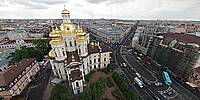
Flying over Vladimirskaya Square
Belfry, Saint Petersburg, Russian Federation
July 19, 2024 - 09:35 UTC
© 2024 Andrew Varlamov, All Rights Reserved.
Vladimirskaya Square (in 1739 - Torgovaya Square, in 1923-50 - Nakhimsona Square) is bounded by Zagorodny Avenue, Vladimirsky Avenue, Kuznechny Lane, Kolokolnaya Street, and Bolshaya Moskovskaya Street. The square was so named after the Church of Our Lady of Vladimir. It was designed by the Commission for St. Petersburg Buildings in the 1740s. The square and streets around it were assigned for the Court Settlement - a settlement of court craftsmen and workers. Vladimirskaya metro station was put into service in 1955, Dostoevskaya metro station in 1991.
Daniil Veretennikov, Alexander Semyonov and Gavriil Malyshev write in the book titled "Enema of Romanticism: A Guide to Post-Soviet Architecture in St. Petersburg" published in 2022 (ISBN 978-5-17-148103-2) - Here it is necessary to understand what the historical center of the city was like at the time of the collapse of the USSR. By that time it was almost completely preserved, both in the public consciousness, traumatized by the destruction of the war and the blockade, and in the architectural practice of modernism - the extensive growth of the city took place on the undeveloped outskirts, and large-scale projects in the center were a rare exception. Numerous empty spaces, chaotic development of courtyards with a pile of outbuildings and outbuildings - this entire medieval inner world of regular Petersburg can be observed today, but then it was looked at from a different angle for the first time. The land, and especially the centrality of its location, suddenly turned out to be capitalized. And this means that the Middle Ages had to be finished and the revival became inevitable...
The shopping and office center "Regent Hall", undoubtedly, is considered an icon of capitalist romanticism. The building, characterized by Mikhail Piotrovsky as "the most outrageous of all that was built in the center", changed the panorama of Vladimirskaya Square forever.
Forever or not? The controversy surrounding the "Regent Hall" has not died down to this day, and its future is difficult to predict - urban preservationists still demand the demolition of the building, and the professional community continues to criticize it: Nikita Yavein called the building "not the best object of Luzhkov's architecture, depicting fake wealth", and another St. Petersburg architect, Sergei Politin, even prepared a concept for its reconstruction in 2013 on a volunteer basis. According to Politin's project, the urban planning error can be corrected by hiding the facade of the building behind a suspended neoclassical one, made in the Suzor spirit, covered by marble, and covering the rotunda with a dome. Such a solution according to the architect, will allow "regenerating the building into a historical and cultural environment and rehabilitating it in the eyes of citizens and guests of the city", harmonizing the proportions of the faсade.
It would be difficult to take this project seriously if the law on the protection of cultural heritage sites did not hang over the building like a sword of Damocles, according to which the dissonant facades of the building are indeed subject to "neutralization". In 2019, 12 years after its opening, "Regent Hall" lost its most important facade element - a giant screen that for many years illuminated the space with advertising as if it were not Vladimirskaya Square, but Times Square. Instead of the screen, a third tier of columns appeared, significantly distorting the original author's design.
It is interesting that the "Regent Hall" is in many ways a product of concessions to the urban conservation community. In the 1980s, the Vladimirskaya metro station was built on the square, and it was planned to demolish the Delvig House (Zagorodny Prospekt, 1) for the sake of constructing its vestibule. These plans met with a strong rebuff from the city residents, who in 1986 formed the Salvation Group to protect the building, which later became a powerful urban conservation movement. The first ever action by St. Petersburg urban conservationists ended in victory - the vestibule was built nearby, deep in the block, and only the three-story building of the Vladimir Diocesan School, built in 1870, was demolished for its sake. Thus, a complex-shaped lacuna was formed on the territory of the square, which, with the advent of the market economy, turned into a valuable asset.
When the development company Fastkom purchased the site in 2001, it gave the KGIOP and urban conservationists an obligation to restore the lost facade of the School and kept it. The architects of the 14th workshop of LenNIIproekt Chulkevich, Zhukov and Yushkantsev close the front of the square with a two-story volume, precisely repeating the proportions and pediment of the lost building. However, above it, in the recess, an 8-story shopping and office center is growing. The curved glass surface of the main facade of the office center is cut through by a colonnade, the building is crowned with a rotunda. The architects, whose previous joint project was McDonald's near Vasileostrovskaya metro station, echoing the nearby St. Andrew's Cathedral, repeat their methods of working with context in the building of "Regent Hall". The radius of the entablature, the paired arrangement of the columns echo the architecture of the opposite belfry of the Vladimir Cathedral, built according to the design of Quarenghi. The temple of trade and business does not compete in the composition of the square with the Lord's temple, but respectfully takes the place of the second most important accent. Here You are the first after God, the building says to its tenants.
The facade facing Zagorodny Prospekt is executed in a much more brutal spirit and rather evokes associations with Stalinist architecture of the transitional period. The heavy volume hangs over the Delvig House on consoles, expanding the functional volume of the building and demonstrating the customer's desire to maximize profit from the area of the site, thereby compensating for the losses from the concession to urban conservationists. The developer subsequently recognized the building as his the most complex project - 900 piles had to be driven in for construction over the inclined metro route.
Lat: 59° 55' 43.36" N
Long: 30° 20' 54.591" E
Precision is: High. Pinpoints the exact spot.
Camera: Pentax K-5 II; Lens: Samyang 8mm f/3.5 UMC Fish-eye CS II; Hot shoe two axis double bubble spirit level: ROWI 197; Cable switch: CS-205; No tripod: due to technology "Flying Willy" by Willy Kaemena; PC Software: PTGui Pro 10.0.19 by New House Internet Services B.V. (dated by June 6, 2018), Pano2VR 6.1.8 pro 64bit by Garden Gnome Software (dated by May 25, 2020), Adobe Photoshop
Владимирская площадь (в 1739 Торговая пл., в 1923-50 пл. Нахимсона) расположена между Загородным и Владимирским проспектами, Кузнечным переулком, Колокольной и Большой Московской улицами. Площадь названа от Владимирской церкви. Создана в 1740-х гг. по проекту Комиссии о Санкт-Петербургском строении. Площадь и окружавшие ее улицы были отведены для Дворцовой слободы - поселения мастеров и служащих при дворце. В 1955 вступила в строй станция метро "Владимирская", в 1991 станция "Достоевская".
Даниил Веретенников, Александр Семёнов и Гавриил Малышев пишут в книге "Клизма романтизма. Путеводитель по постсоветской архитектуре Санкт-Петербурга", выпущенной в 2022 году (ISBN 978-5-17-148103-2) - Здесь необходимо понимать, что же представлял собой исторический центр города на момент распада CCCP. К этому времени он был практически полностью законсервирован, как в общественном сознании, травмированном разрушениями войны и блокадой, так и в архитектурной практике модернизма - экстенсивный рост города шёл
на неосвоенных окраинах, и масштабные проекты в центре были редким исключением. Многочисленные пустоты, хаотичная застройка дворов нагромождением флигелей и хозпостроек - весь этот средневековый внутренний мир регулярного Петербурга можно наблюдать и сегодня, но тогда на него впервые посмотрели с другого ракурса. Земля, и в особенности центральность её расположения, внезапно оказались капитализированы. А это значит, что со средневековьем надо было заканчивать и возрождение становилось неизбежным...
Торгово-офисный центр "Regent Hall", без сомнений, является иконой капиталистического романтизма. Здание, охарактеризованное Пиотровским как "самое вопиющее из того, что было построено в центре", изменило панораму Владимирской площади навсегда.
Навсегда ли? Споры вокруг "Регент-Холла" не утихают до сих пор, и его будущее сложно предсказать - градозащитники по сей день требуют сноса здания, не перестаёт критиковать его и профессиональное сообщество: Никита Явейн назвал сооружение "не лучшим объектом лужковской архитектуры, изображающим липовое богатство", а другой петербургский архитектор, Сергей Политин, в 2013 году даже подготовил на волонтёрских началах концепцию его реконструкции. Согласно проекту Политина, градостроительную ошибку можно исправить, спрятав капромовский фасад здания за навесным неоклассическим, выполненном в сюзоровском духе, под мрамор, и накрыв ротонду куполом. Такое решение, по мнению архитектора, позволит "регенерировать здание в историко-культурную среду и реабилитировать его в глазах горожан и гостей города", гармонизировав пропорции фасада.
Этот проект сложно было бы воспринимать всерьез, если б над зданием не нависал дамокловым мечом закон об охране объектов культурного наследия, согласно которому диссонирующие фасады постройки действительно подлежат "нейтрализации". В 2019 году, спустя 12 лет после открытия, "Regent Hall" лишился важнейшего фасадного элемента - гигантского экрана, долгие годы озарявшего пространство рекламой словно не Владимирская площадь, а Times Square. Вместо него появился третий ярус колонн, значительно исказивший первоначальный авторский замысел.
Интересно, что "Регент-Холл" является во многом продуктом уступок градозащитному сообществу. В 80-е на площади строилась станция метро "Владимирская", ради возведения вестибюля которой предполагалось снести Дом Дельвига (Загородный пр., д.1). Эти планы встретили жёсткий отпор горожан, в 1986 году сформировавших для защиты здания Группу Спасения, ставшую потом могущественным градозащитным движением. Первая в истории акция петербургских градозащитников завершилась победой - вестибюль был построен рядом, в глубине квартала, ради него был снесён лишь трёхэтажный корпус Владимирского епархиального училища 1870 года постройки. Таким образом, на территории площади образовалась лакуна сложной формы, которая с приходом рыночной экономики превратилась в ценный актив.
Девелоперская компания "Фастком" при покупке в 2001 году участка дала КГиОПу и градозащитникам обязательство восстановить утраченный фасад Училища и сдержала его. Архитекторы 14-й мастерской ЛеНИИпроекта Чулкевич, Жуков и Юшканцев закрывают фронт площади двухэтажным объёмом, точно повторяющим пропорции и фронтон утраченного здания. Однако над ним, в углублении, вырастает 8-этажный массив торгово-офисного центра. Изогнутую стеклянную поверхность главного фасада офисного центра прорезает коллонада, здание венчается ротондой. Архитекторы, предыдущим совместным объектом которых был "Макдональдс" на Василеостровской, перекликающийся с расположенным рядом Андреевским собором, повторяют свои приемы работы с контекстом и в здании "Регент-Холла". Радиус антаблемента, спаренное расположение колонн перекликаются с архитектурой расположенной напротив колокольни Владимирского собора, построенной по проекту Кваренги. Храм торговли и бизнеса не соперничает в композиции площади с храмом Божьим, а уважительно занимает место 2-го по значимости акцента. Здесь вы - первые после Бога, говорит постройка своим арендаторам.
Выходящий на Загородный проспект фасад выполнен в куда более брутальном духе и вызывает скорее ассоциации со сталинской архитектурой переходного периода. Тяжеловесный объем нависает над Домом Дельвига на консолях, расширяя функциональный объем здания и демонстрируя желание заказчика максимизировать прибыль с площади участка, компенсировав тем самым потери от уступки градозащитникам. Девелопер впоследствии признал здание самым сложным своим объектом - для строительства над наклонным ходом метро пришлось вбить 900 свай.
Short-term weather forecast from Yandex promised rain after 14:00 local time, but rain started at 12:30. I had got enough time to make shots of city from belfry before rain, but shots of zenith were made already after rain in the square.
8mm lens was chosen specially to unweight camera and to obtain sharp images, and the attempt was successful.
There are 8 pairs of columns under the dome of belfry and octagonal observation deck for visitors. Of course, these 8 high and wide openings were surrounded by stone handrails and by decorative metal grids of vertical rods. The distance between the bars of the gratings is sufficient to pass through it the hand, holding the DSLR camera, for nadir images.
Stitching of the panorama was common and humble - I can't to report anything new. Roof of the belfry was combined manually from fragments of Vladimir Cathedral's roof.


 Tap or click the zoom icon in the bottom right corner of the picture to switch between in-page and fullscreen view
Tap or click the zoom icon in the bottom right corner of the picture to switch between in-page and fullscreen view